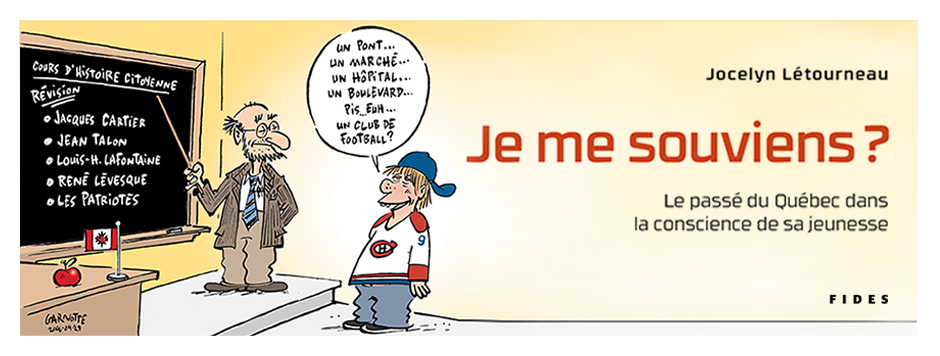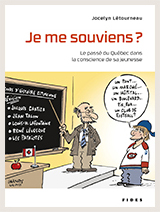The statements
The PDF documents below contain the primary materials used for the book:
- Form for the general survey
- Statements cited in the book (in the order of appearance in each chapter) coded by educational institution
- Statements gathered before the effective introduction of the academic reform (2007)
- Sec IV (French) statements, general classification, by sex and region
- Sec V (French) statements, general classification, by sex and region
- Cégep (French) statements, general classification, by sex and region
- University (French) statements, general classification, by sex and region
- Sec IV (English) statements. general classification, by sex and region
- Sec V (English) statements, general classification, by sex and region
- University (English) statements, general classification, by sex and region
- Statements about Aboriginals (all levels)
- Statements about Canada (all levels)
- Statements gathered after the effective introduction of the academic reform (2007)
- Results of the study carried out at the Musée de la civilisation (Québec City)
- Statements generated by the Léger Marketing survey conducted on behalf of the Association for Canadian Studies
A short history of the book
Every book has its own history. The idea behind Je me souviens ? dates back to the late 1980s. As a member of the jury for the Lionel-Groulx competition sponsored by the Institut d’histoire de l’Amérique française, the author became aware that the youth, invited to write an essay on the history of contemporary Québec, held a picture of the past that was largely structured by the “Great Darkness/Quiet Revolution” dichotomy. He sought to understand why this was so. From that moment on, the idea of the historical conceptions of young people has refused to let him go.1
As a father of four, Jocelyn Létourneau never fails to be impressed by the curiosity and intelligence of young people. He believes that we drastically underestimate their capacity for thoughtful consideration. The youth’s ignorance of and indifference to the history of Québec was a matter of popular debate in the province during the 1990s. The verdict was harsh: the young people were called a generation of amnesiacs, teens with broken memories, youth with no historical roots.
Puzzled by these opinions, which were often based on surveys of questionable construction, Jocelyn Létourneau came up with the idea of questioning the youth differently. In his courses at the Université Laval, he surprised his students with a fairly simple request – “Tell me the history of Québec as you know it” – and with a seemingly straightforward question: “If you had to sum up Québec’s historical journey in a single sentence or phrase, what would you say?” Year after year, he gathered stories and statements. Busy working on other projects, he had little time to examine his extraordinary collection, but he was slowly compiling a series of questions, hypotheses and concepts to which he intended to subject his data.
In the early 2000s, he convinced Sabrina Moisan, then just beginning her graduate studies, to extend the research by taking the survey to high schools and cégeps in the Québec City region. The brilliant student produced an excellent thesis.2 Moisan and Létourneau’s work formed the basis of an important article3 that had significant repercussions: not only was the text widely cited and quoted,4 but it led government decision-makers to re-examine the state of the historical understanding of young Quebecers. After the publication of this text, the supposed “ignorance” of the youth was no longer understood as an emptiness waiting to be filled but rather as a fullness that could be turned to account.
The reception of his idea encouraged Jocelyn Létourneau, in 2003, to undertake wider, more systematic documentary research. With the help of Christophe Caritey and a team of students, he used the same efficient method to gather hundreds and then thousands of narratives and statements from Québec youth living in a variety of regions and attending French or English schools. The statements compiled, which constitute one of the world’s largest collections of this kind, where then coded to extract the content. So far, only a few articles have been published analysing them:5 much work remains to be done, and the results promise to be fascinating.
The narratives produced by the youth offer almost inexhaustible source of raw data, and the statements they wrote are equally promising. Originally, Jocelyn Létourneau’s intention was to write an article about the statements, but given the wealth of the collection, the potential of which could never be fully exploited in thirty pages, he decided to write a book. This allowed him to analyse the statements from different angles and in the depth required of a study that would be meticulous, rigorous and ambitious and that would have practical applications for the teaching of history.
It takes time to produce a book: the author cannot be dedicated full-time to this single project. Developing a classification method for the sentences also required considerable time. And the classifications had to be validated, the assignment of each statement to one category or another had to be discussed, and so on. The original classification system developed by Jocelyn Létourneau was submitted to Raphaël Gani and Jean-François Conroy for input. After discussion, the final classification was confirmed, and on that basis the book was produced.
Notes
- Jocelyn Létourneau, «L’imaginaire historique des jeunes Québécois», Revue d’histoire de l’Amérique française, 41, 4 (printemps 1988), p. 553-574.
- Sabrina Moisan, «Mémoire historique de l’aventure québécoise chez les jeunes Franco-Québécois d’héritage canadien-français. Coup de sonde et analyse des résultats», mémoire de maîtrise, département d’histoire, Université Laval, 2002.
- Jocelyn Létourneau et Sabrina Moisan, «Mémoire et récit de l’aventure historique du Québec chez les jeunes Québécois d’héritage canadien-français: coup de sonde, amorce d’analyse des résultats, questionnements», Canadian Historical Review, 85, 2 (juin 2004), p. 325-356.
- Jocelyn Létourneau et Sabrina Moisan, «Young People’s Assimilation of a Collective Historical Memory. A Case study of Quebeckers of French-Canadian Historical Heritage», dans Theorizing Historical Consciousness, sous la dir. de Peter Seixas, Toronto, University of Toronto Press, 2004, p. 109-128; Jocelyn Létourneau, «Remembering Our Past: An Examination of the Historical Memory of Young Québécois», dans To the Past: History Education, Public Memory, & Citizenship in Canada, sous la dir. de Ruth Sandwell, Toronto, University of Toronto Press, 2006, p. 70-87.
- Jocelyn Létourneau et Christophe Caritey, «L’histoire du Québec racontée par les élèves de 4e et 5e secondaire. L’impact apparent du cours d’histoire nationale dans la structuration d’une mémoire historique collective chez les jeunes Québécois», Revue d’histoire de l’Amérique française, 62, 1 (été 2008), p. 69-93 ; Stéphane Lévesque, Jocelyn Létourneau et Raphaël Gani, «A Giant with Clay Feet: Quebec Students and the Historical Consciousness of the Nation», International Journal of Historical Learning, Teaching and Research, vol. 11, 2 (mai 2013), p. 156-172; Jocelyn Létourneau, Raphaël Gani et Stéphane Lévesque, «Tout a commencé par la défaite. La guerre de Sept Ans dans la mémoire et la conscience historiques des Québécois», dans Laurent Veyssière, dir., La Nouvelle-France en héritage, Paris, Armand Colin, 2013, p. 311-327.
Related articles
Here is a selection of articles published by the author or by other researchers that are related to the subject matter of the book.
List of publications:
- Jocelyn Létourneau, «La fin de l’histoire québécoise? L’histoire du Québec pour les Nuls, d’Éric Bédard», Recherches sociographiques, vol. 54, 1 (2013), p. 165-182.
- Jocelyn Létourneau, «Faut-il craindre une autre histoire du Québec?», Thèmes canadiens/Canadian Issues, automne 2006, p. 86-90.
- Vincent Fontaine, «Cours d’histoire du Québec au secondaire la question nationale est-elle aussi absente qu’on le dit», octobre 2012, 7 p.
- Raphaël Gani, « Comment résumeriez-vous l’histoire de votre pays? Enquête auprès de Canadiens, d’Américains, de Britanniques et de Français (2011) », mémoire de maîtrise, Université Laval (histoire), 2014, 140 p.



